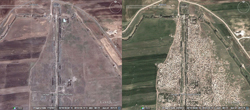KU class documents destruction of ancient Syrian sites
LAWRENCE — The Syrian civil war that began in 2011 has created or fueled a myriad of crises: deadly violence, displacement of thousands of families, the destruction of ancient historic sites, and the rise of the Islamic State group in the Middle East.
 Most of the headlines about destruction of ancient sites in Syria have focused on last year's Islamic State destruction of two 2,000-year-old temples at Palmyra. However, a University of Kansas Classics class from thousands of miles away has shed light on the extent of the damage to other culturally significant sites not often in the public eye.
Most of the headlines about destruction of ancient sites in Syria have focused on last year's Islamic State destruction of two 2,000-year-old temples at Palmyra. However, a University of Kansas Classics class from thousands of miles away has shed light on the extent of the damage to other culturally significant sites not often in the public eye.
KU undergraduate students in CLSX 151, Introduction to Classical Archaeology, a fall class of Associate Professor Phil Stinson, used Google Earth satellite images to track the conditions of four sites in northern Syria, including Apamea and Ebla.
"For future archaeologists, I think this satellite imagery is going to be critical to try to reconstruct what happened in this terrible period in Syria's history," Stinson said.
The students used the images to document what appeared to be illicit excavation of the ground around sites like Apamea, which was home to the Great Colonnade, believed to be one of the longest and most famous in the Roman world.
In 2011, satellite images show green grass and unbroken ground at Apamea near the Colonnade ruins, and by 2014 the site was littered with hundreds of random pockmarks, leaving the ground looking like a poorly constructed chessboard. Professional archaeologists would not leave the site looking that way, Stinson said.
"The site had beautiful colonnades, mosaics, murals and all sorts of physical remnants of the city that used to be there. Those are now scattered," said Rebecca Joy, an Overland Park senior majoring in anthropology and minoring in classics. "People have come in with pick axes, bulldozers, dynamite and what hasn't been destroyed outright has been looted."
The students supplemented the visual evidence they collected with whatever they could find, including news accounts, which are somewhat scarce.
One of the main pieces of information students gathered was that most of the excavation is not at the hands directly of Islamic State militants destroying sites but likely individuals facing hardships due to the war.
"Mainly it's illicit excavation for the purposes of finding treasure, so to speak, that can be sold on the antiquities market," Stinson said.
Joy said there is evidence of black market vans traveling around Syria that contain a hodgepodge of items reportedly taken from Apamea, including a mosaic from a floor.
"It's a horrible catch-22 because so much of the strife and warfare in the area has damaged the normal infrastructure. Everyday people just don't have an opportunity to make a living, so unfortunately they feel that this is the only way to make a quick buck in order to feed their families," she said.
There are accounts of Islamic State militants coming into the game late by enlisting local residents to excavate items from sites and then taking a cut of whatever is found and sold on the black market to fund their operations in Syria, Iraq and elsewhere, Stinson and Joy said.
Samantha Foreman, a Leavenworth sophomore majoring in theatre and pursuing a minor in classics, who examined the Ebla site — home to an ancient library — interpreted evidence of a military encampment constructed there. Foreman said the research was eye opening but also heartbreaking because the story doesn't tend to receive much attention internationally.
"The fact that we don't really look into this in the first place is pretty significant," she said. "We don't hear as much about Syrian culture and history. We are just losing fragments of the past that we won't be able to study or understand any more."
The course fulfilled the critical thinking requirement under the KU Core Curriculum.
"In the widest possible significance of the project, I think it teaches and encourages students to be good global citizens. It helps students appreciate their own cultural heritage and appreciate global cultural heritage more," said Stinson, who is interim co-director of KU's Institute for Digital Research in the Humanities, or IDRH. "A more practical goal was to allow the students to use a very powerful digital tool that is commonly used in archaeology today and also in the digital humanities."
Stinson said unfortunately it's unclear how or even when the conflict in Syria will end and what conditions would even be for potential restoration of the sites.
"At the rate they're going there may not be anything left on these sites unfortunately or the stratigraphy will be so disturbed that it will be difficult to reconstruct the context for any loose find," Stinson said. "Context is the critical element in any archaeological research, so we can only hope that the civil war and conflict ends soon and that archaeologists can return to these sites to try to repair some of the damage that's been done. I think realistically that would have to be an international efforts, not just the effort of a few archaeologists."